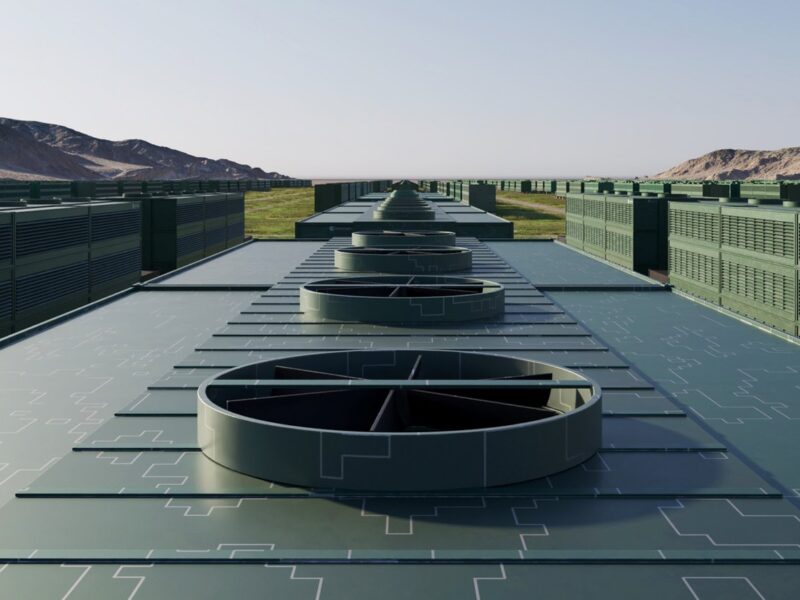Wyoming’s Long Shot Bet on ‘Clean Coal’ (Part 2)
As the US moves away from coal-fired power, state looks to carbon removal technology to revamp industry
- Published In: Other News & Features
- Last Updated: Feb 21, 2023

An artist's rendering depicts a row of direct air capture machines at the Project Bison site. By 2030, these machines will draw five million metric tons of CO2 from the air each year. (Courtesy image from CarbonCapture Inc.)
By Samuel Gilbert
Special to the Wyoming Truth
Wyoming’s embrace of Project Bison is one part of a much larger bet on traditional carbon capture utilization and storage technologies (CCUS).
Unlike direct air capture (DAC) technology, which pulls carbon from the atmosphere and can exist anywhere in the world, CCUS systems are placed atop smokestacks at power plants and other industrial emitters, capturing CO2 at the point of emission.
Proponents claim this technology is vital to promoting “clean coal” and the continued burning of fossil fuels in that it can, theoretically, allow power plants to operate without releasing climate-warming gasses.
Critics, including over 500 environmental organizations, argue that CCUS is not a climate solution but an expensive and energy-intensive technology that prolongs the life cycle of the fossil fuel industry by allowing coal and gas plants to continue to operate.

“CCUS is a way of embedding fossil fuel energy in the system for longer, so incumbent gas and coal producers like to see the technology subsidized and utilized,” said Bruce Robertson, energy finance analyst for the Institute of Energy Economics and Financial Analysis (IEEFA), noting the lucrative incentives for CCUS projects in the Inflation Reduction Act that benefit big coal and oil.
Wyoming, which derives nearly 60% of its revenue from fossil fuels, has been pushing CCUS for years. The state has the world’s largest CCUS facility and has spent millions on storage and carbon transportation technology. In December, Gov. Mark Gordon proposed an additional $50 million to help lure carbon capture and storage projects, as well as hydrogen fuel and rare earth mineral mining to Wyoming.
Shannon Anderson, a staff attorney with the Powder River Basin Resource Council, said that Wyoming has been “boosting” carbon capture technology for years, courting industry and setting “national standards for issues like liability and pore space ownership.”
In 2020, Gordon signed the nation’s first law requiring the state’s electric utilities to generate some of their energy from coal plants retrofitted with CCUS technology.
“I recently set the goal for Wyoming to not only be carbon neutral but actually carbon negative while continuing to use fossil fuels,” Gordon said that year. Wyoming produces 40% of the nation’s coal and relies on coal-fired power plants to provide over 70% of the state’s electricity.
As coal power plants shutter nationwide amidst demands for cleaner energy sources — 2020 saw the lowest amount of coal-fired power generation in the US since 1949 — Wyoming is using CCUS to protect its economic interests.
“You have jobs and revenue for the fossil fuel industry that you are trying to prolong,” Anderson said of the 2020 law. “This is not from a climate perspective. It’s not from an environmental perspective. It’s from a very local interest.”
There are only two coal power plants in Wyoming without a closure date.
According to Anderson, there are proposals to retire six units and convert two others to gas at three large coal plants in Wyoming by the end of the decade. But the 2020 law could prolong their operation.
“You’re going to be generating CO2 that would not have otherwise gone into the atmosphere,” said Anderson.
Economic uncertainty
In early February, the Wyoming Senate passed Senate File 142 further expanding carbon capture requirements for coal plants. The bill will make it even more difficult for Wyoming’s largest public electric utilities — Rocky Mountain Power and Black Hills Energy — to shutter their coal plants.
The bill could allow the continued operation of the Dave Johnston Power Plant located east of Casper. When asked about his support for the bill, Sen. Bill Landen (R-Natrona County) pointed to the plant’s importance to the region.
“The concept of utilizing carbon emissions, the CO2 emitted in the burning of coal, to enhance the oil recovery in one of our older fields is compelling enough to support the bill,” Landen told the Wyoming Truth. “In testimony, we learned that the technology might not be there, but again it is worth the effort. Enhanced oil recovery works, and if this project can come to fruition it stands to benefit Wyoming.”
Organizations such as The Intergovernmental Panel on Climate Change and the International Energy Agency nonetheless view CCUS technology as crucial in combating climate change.
According to the UN, CCUS “can play a significant role in mitigating carbon emissions in the future and is a key technology for the decarbonization of the energy sector in the long term.”
The IEEFA report, co-authored by Robertson, examined 13 carbon capture and storage projects — seven of which underperformed and three closed. “These projects are littered with failure,” Robertson said.
The economics of carbon capture remain uncertain, even amidst growing subsidies and tax credits from the federal government. The cost to retrofit one coal plant in Wyoming is between $400 million to $1 billion, according to the utility company PacifiCorp, which operates as Rocky Mountain Power in Wyoming.
“You tack on more expensive pollution control. Is that really the way to make coal more affordable?” asked Anderson.
Black Hills Energy Corporation, which operates two coal plants in Wyoming, estimated the price tag to retrofit its coal units would cost Wyoming ratepayers an additional $100 a month.
“The costs of potential CCUS projects on power plants in Wyoming will lead to very high electricity bills for consumers,” said Robertson. “In Wyoming, it will lead to the need to build new power plants just to supply the energy to capture the CO2.”
‘Climate-friendly’ oil production
CCUS technologies have another use: to produce more oil. Beginning in the 1970’s, oil and gas companies began, on a commercial scale, using CO2 separated from methane during the extraction process and pumping it into dwindling oil and gas reservoirs to recover previously unreached reserves.
Robertson said enhanced oil recovery (EOR) was an oil and gas production technique that was “deftly rebranded” as CCUS to make it appear “more climate-friendly.” The Biden Administration’s $3.7 billion in funding for carbon capture projects includes taxpayer dollars for enhanced oil recovery.
To date, most carbon captured globally has been used for EOR projects to produce more oil and gas. Otherwise, untappable oil reserves are accessed by injecting CO2 into depleted fields, while oil companies claim tax incentives and avoid penalties for theoretically limiting their emissions.
“You have CO2 that would not have been emitted,” said Anderson, the attorney. “It would have stayed underground. From our math, that is adding carbon, not taking it away.”
Wyoming-based Glenrock Energy plans to use EOR at its properties throughout the state.
For Robertson, the growing focus on these technologies fails to address the root cause of global warming and its most apparent solution. “Wind, solar and batteries represent proven, effective and cheaper alternatives to address global warming,” he said. “It is far cheaper and more effective to just not emit in the first place.”













